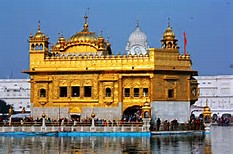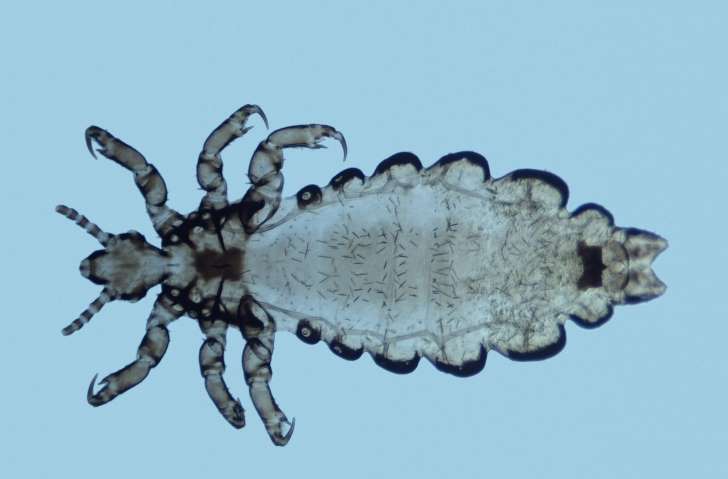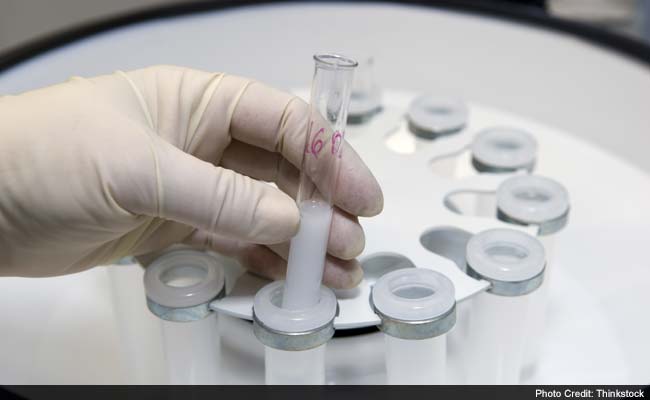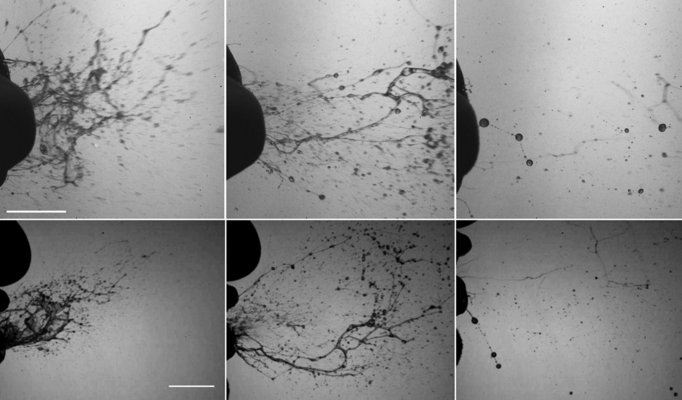
Countless devotees laid down their lives to preserve the glory of Harimandir at different times of history. When in 18th century, Massa Ranghar, the Mughal Commandant of Amritsar appointed by Zakariya Khan, converted Harimandir into a police post, and a stabling, and polluted it further by using the central shrine as a dancing hall, he was beheaded by two valiant Sikhs – Mehtab Singh and Sukha Singh – in 1740.
When Timur Shah (son of Ahmad Shah Abdali), governor of Punjab, defiled Harimandir, Baba Deep Singh (1686-1757) managed to avenge the humiliation with his limited resources. During an encounter with rival forces, which took place about eight miles from Amritsar, he received a fatal cut on the neck. Undeterred, he held his almost -severed head into his left hand, and kept fighting before reaching Harimandir, where he dropped dead. A monument to commemorate his heroic act is enshrined in Gurudwara Sahib Baba Deep Singh.
The Afghan invaders destroyed Harimandir thrice in the 18th century – 1757, 1762 and 1764 . Its reconstruction began after Sardar Jassa Singh Ahluwalia (1718-1783) laid its foundation again in 1764. Voluntary contributions gathered by Bhai Des Raj, a banker of Amritsar, and others expedited the completion of the sacred shrine.
After capturing Amritsar Maharaja Ranjit Singh (1780-1839) appointed a committee of prominent citizens to supervise the affairs of Harimandir, and gave some jagirs for its upkeep. A number of bungas -dwelling places- were constructed for pilgrims who came from far off places. Maharaja visited Harimandir occasionally for having a dip in the sacred sarovar, and for prayer, ardas. He got the shrine embossed with marble and gold, and since then, it is famous as Swarn Mandir or Golden Temple. A detailed account of Maharaja’s devotion to Harimandir is contained in Sohan Lal Suri’s Umdat-ut-Tawarikh .
For giving a facelift to the shrine , Maharaja engaged skilled architects, masons and wood carvers from Chaniot, now in Pakistan. He made rich contribution to the toshakhana of Harimandir by donating four pairs of gold-plated doors which are fitted only on special occasions, a gold umbrella bedecked with gems, a string of 108 pearls, a jewel-studded headband, and a magnificent canopy, made of rich cloth with embroidered work in silver and gold, which was destroyed during operation bluestar.
The benevolent acts of Maharaja have been preserved in a gold-plated inscription on the main entrance to the holy shrine. It says: Shri Maharaj Guru Sahib ne apne param sevak sikh jaankar Shri Darbar Sahib ji ki seva Shri Maharaja Singh Sahib Ranjit Singh par daya kar ke karai, i.e. ‘The great guru through his munificence regarded Shri Maharaja Singh Sahib, Ranjit Singh, as his dear disciple and servant, and got this work done by him.’
The gold inlay work in Harimandir was continued by Maharaja’s successors. After the annexation of Punjab in 1849, the control of Harimandir came into the hands of the British resident. Subsequently, at the behest of the Deputy Commissioner of Amritsar, a Committee of prominent Sikhs was appointed to render help in its day-to-day administration. But it failed to achieve much, as the strings of power remained with the British. The construction of Clock Tower in 1862 by demolishing the bunga, a defensive structure, of Kanwar Nau Nihal Singh, grandson of Maharaja Ranjit Singh (1821-1840) and the attari of Rani Sada Kaur , mother-in-law of Maharaja Ranjit Singh ( d.1832), was resented by the Sikhs who thought that it was meant to increase surveillance over the shrine. Sporadic efforts were made to free Harimandir till the formation of the Central Sikh League in 1919 which passed a resolution demanding the total control and administration of the Sikh religious shrines. The success of Akali agitation for the possession of keys of Harimandir in 1922 left Mahatma Gandhi jublilant to the extent that he sent a telegram to Baba Kharak Singh (1868-1963) which read: ‘First battle of India’s freedom won. Congratulations’.
Incessant struggles against the British culminated in the passing of the Sikh Gurudwara Act in 1925 whereby the control of hereditary mahants and pujaris over the shrine came to an end. A subsequent amendment to the Act, about two decades later, entrusted the task of administration to Shiromani Gurudwara Parbandhak Committee (SGPC). Since then, the control of the shrine has remained in its hands except for short intervals during the political turmoil in Punjab.
Harimandir provides a veritable feast to the eyes because of the sublimity of its conception, and the perfection of its beauty. The double-storeyed marble-structure raised on a square platform in the centre of the pool of nectar creates an awesome impression on the mind. The central shrine can be approached through the darshni deorhi-gateway- by a causeway which is about 60 metres long. Its reflection falling in limpid waters of the sarovar gains its effect from the light and shade of the sun and the moon.
The lower portion of the shrine is of white marble, to some 6 feet, and above it the walls are adorned with plates of gilded copper. All the four door-ways are embellished with finely wrought silver. The darshani deorhi with its exquisite portal frame, panels, ivory inlay work, geometrical and floral designs in green and red, and air-houses in the Bengal Mughal Chhatri style is both imposing and graceful. The gold – embossed pannellings above marble frontages of the shrine, ornamental work of naqqashs or painters on walls, gilded plates on cornices, roofs, cupolas and columns, inlay work on ceilings, and the lamps on the causeway make one feel as if one has entered the heaven.
The upper floor of the temple has a miniature hall of mirrors called Sheesh Mahal. Its walls are adorned with matchless floral designs, and on its arches are inscribed sacred hymns in gold letters. A square orifice in the centre of the hall provides visitors with an opportunity to have a glimpse of the ground floor, and enjoy kirtan in a tranquil mood. Tradition says that Sheesh Mahal was originally used by the Sikh gurus for meditation, but now it is a place for performing akhand paths – non-stop recitation of the holy Granth. In the centre of upper storey lies the resplendent golden dome. Four equally fascinating domes stand on the parapet of the shrine beside others.
The way to treasure-house of the shrine on the first floor of the darshni deorhi lies through massive silver doors and a staircase. It contains a number of precious articles which are displayed only on special occasions. The Sikhs describe this show of imposing pomp and grandeur as jalau– the word jalau is derived from the Arabic jalwa meaning display of splendor.
There is a long circumambulatory path encircling the sarovar which the devotees traverse with a religious zeal that is to be seen to be believed. Referring to the majestic splendour of the Harimandir, Percy Brown, wrote: ‘As an example not so much of architectural style but of religious emotion materialized in marble, glass, colours and metal; the Golden Temple at Amritsar is equaled only by the Shwe Dragon Pagoda in Rangoon; the former symbolizes the faith of the Sikhs, and the latter is the highest expression in a very similar range of material of another Indian religion, that of the Buddhists.’
Harimandir reflects the Word of God. Sri Guru Granth Sahib is kept on a raised platform under a scintillating canopy bedecked with precious gems. Every morning the holy Granth, in attractive rumalas– robes- is carried out in a golden palanquin from Kotha Sahib situated on the Akal Takht to the sanctum sanctorum , and taken back to the same hallowed place at about 11 P.M. Before the holy Granth sit the Sikh priests chanting hymns and passages from it in an unending manner. The devotees come in millions, to pay obeisance to the holy book and make offerings of various kinds like flowers, garlands, karah Prasad and plain cash Some devotees take bath in the holy sarovar and recite the Japji Sahib composed by Guru Nanak Dev, before going to the shrine. Those who bring karah prasad get back a portion of it after the priest -granthi – makes prayers on their behalf. Each member of the sangat –congregation- receives prasad irrespective of whether he has brought any offering or not.
Referring to the virtues of karah prasad, Krishan Kaur Mishra writes that the sanctified pudding, karah, is made up by frying wheat flour, ghee and sugar in a pan. It gives success in all human endeavours, and is worthy of adoration. (Shreyamkam, 5.7). The pilgrims make it a point to go to Har ki Pauri, steps on the east of the pradakshina– ‘procession- path’- to take a handful of nectar from sarovar after making obeisance.
The day in Harimandir begins with the recitation of Asa di Var, ‘ Ballad of Hope’ composed by Guru Nanak Dev, and ends with kirtan. Kirtan or the singing of sacred hymns from Sri Guru Granth Sahib goes on uninterruptedly till the gates of the shrine are closed at night. Ardas, the Sikh Prayer, is made six times a day, to invoke divine blessings.
An important place of worship near Harimandir is the shrine of Baba Atal about which it is commonly said: Baba Atal, deve pakki pakaee ghal (‘Baba Atal gives food duly cooked’). It is a nine-storeyed structure built between 1778 and 1784 to commemorate the memory of Atal Rai (1619-1628) the prodigious son of Guru Hargobind who died at the age of nine. According to tradition, Baba Atal revived his playmate, Mohan, after he had died. Guru Hargobind was annoyed at this miracle as such acts are shunned in Sikhism. To atone for this, Baba Atal went into samadhi and never returned to physical consciousness. Among other ancillary shrines in Harimandir are : Gurudwara Lachi Ber, Gurudwara Thara Sahib, Ber Baba Buddha ji, Dukh Bhanjani Ber, Athsath Tirath and Gurdwara Shaheed Bunga Baba Deep Singh.
Harimandir attracts heavy rush throughout the year, more so on samkrantis,amavasyas gurpurabs (Skt. guruparvas) and important festivals like Diwali and Baisakhi. Accommodation to pilgrims is provided free or on nominal rent in Guru Nanak Niwas, Sri Guru Ram Das Niwas, Akal Rest House, Guru Hargobind Niwas, Guru Arjun Dev Niwas and Mata Ganga Ji Niwas. The free kitchen – Guru Ram Das Ka Langar- is open to all without any distinction of caste,colour,creed or nationality.
Harimandir is divinity crystallized in human structure. Its aura pulls one towards it and strengthens belief in the One Supreme Being. As one views the abode of bliss in its regalia and sublimity, an overwhelming feeling of reverence envelopes, dissolving one’s ego(haumai). It thus makes the inward journey towards the Infinite possible.
Dr Satish K Kapoor, a former British Council Scholar, was Principal, Lyallpur Khalsa College,Jalandhar and Registrar,DAV University, Jalandhar( Punjab).


 South Asian News E-Paper
South Asian News E-Paper Punjabi News E-Paper
Punjabi News E-Paper

















